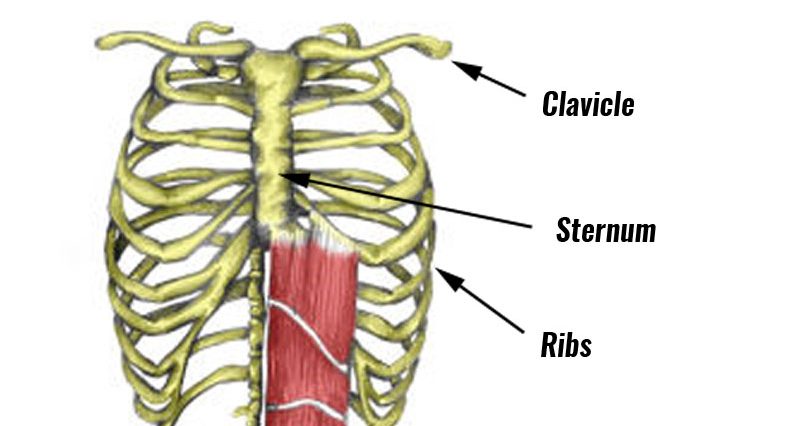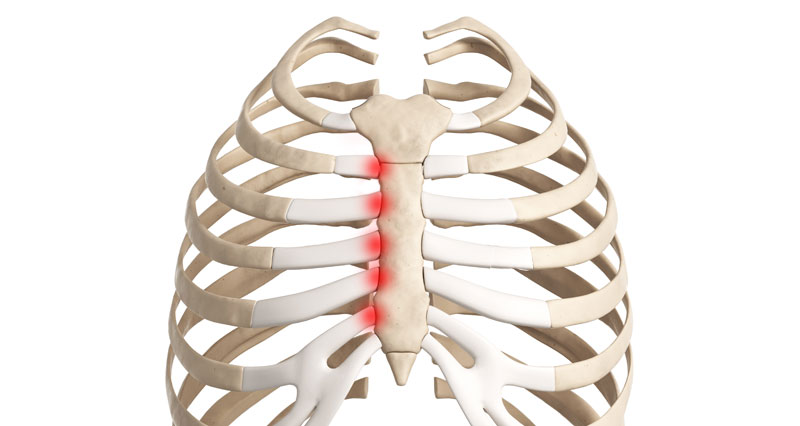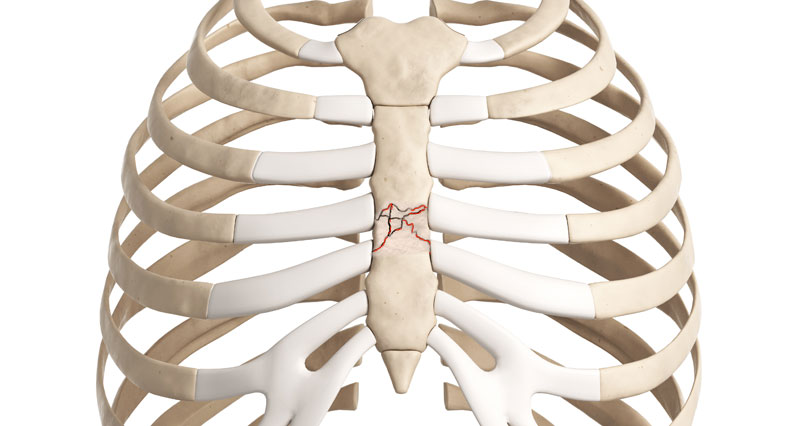The most common injuries to the ribs are contusions and fractures caused by direct impact. A stress fracture of the rib is rare, but can also occur through overuse. Here we explain the symptoms, causes, and treatment of rib injuries.
Bruised ribs
Bruised ribs or a rib contusion occurs following a direct impact to the chest. This may be because of a fall or direct impact from a hard object, but the most common cause is a car accident. Chest pain and difficulty breathing are two main symptoms that can be helped with rest and ice. The injury should be assessed to confirm it is not a more serious condition.
Bruised ribs symptoms
The most obvious symptom of a bruised rib or contusion will be sudden pain on impact. The patient may experience pain in breathing or may feel winded. Bruising can appear over the following hours and the ribs will most likely be tender to touch. Coughing or sneezing can also be painful.
Treatment
Seek medical attention to rule out rib fractures and complications such as pneumothorax or a collapsed lung. Rest is important to allow the tissues to heal. Applying Cold therapy can help reduce pain and swelling. Bruised ribs tend to heal by themselves in a week or two. Padding the injured area with tape can add some protection. A doctor may prescribe anti-inflammatory medication to ease pain and inflammation, making normal breathing more comfortable.
If the injury is painful then it is best not to continue to train or play. Body Armour or padding may be worn in contact sports to protect the area when returning to the sport but this should only be done when pain allows.
Rib fracture/Broken ribs
A rib fracture is common in contact sports and usually occurs following a hard impact to the chest by an elbow or similar. Breathing will often be painful and there will normally be a particular point on the ribs that will be especially tender. It is possible that the fracture may cause internal damage so seeking medical advice is recommended, especially if the pain is severe.
Symptoms
Symptoms of broken ribs include pain and swelling at a particular point over the rib cage. The patient is likely to feel pain when breathing deeply, coughing or sneezing. One significant sign is pain or tenderness at a particular point on the ribs when pressing in over the whole of the rib cage.
Treatment
There is not a great deal that can be done for a rib fracture. Rest is important. If it is very severe then you should seek medical attention to ensure no damage has been done inside the rib cage. If you have a particularly bad fracture of the ribs you would know about it due to severe pain.
A doctor can also not do a great deal other than X-ray the ribs and rule out any internal damage. If it is not a severe fracture then you should be back in action from between 3 to 6 weeks so long as you rest. If you do not rest then it will not be given the chance to heal.
Stress Fracture of the Ribs
Stress fractures of the ribs can be caused by excessive contraction of the muscles that attach to the ribs such as the serratus anterior. General chest pain and back pain may be felt which gets worse with activity and when breathing deeply. Sports like tennis and baseball are common causes of this injury as they involve repeated muscle contractions that put a strain on the ribs.
Symptoms
Symptoms include a gradual onset of chest or back pain. Pain may be felt on one side, but difficult to pinpoint the exact location. Pain is usually worse on deep breaths, as well as coughs and sneezes and get worse with activity and eases with rest. Tenderness when feeling the rib involved (although this may be hard to locate).
Baseball pitchers tend to suffer stress fractures of the first rib as might tennis players and other overhead sports. Repeated contraction of the anterior scalene muscle (in the neck) pulls on its attachments on the 1st rib, causing a stress fracture. Rowers tend to get stress fractures of the 4th or 5th ribs which are caused by contractions of the serratus anterior muscle.
Treatment
- Treatment may involve rest and immobilization in a sling.
- Pain may take two weeks or more to go with a return to sports-specific training taking 8 or more weeks.
Costochondral separation/Rib separation
A Costochondral separation, sometimes known as a rib separation, usually occurs after a direct impact. This injury occurs when a rib becomes separated from the costochondral joint (made from cartilage) which is also attached to the breastbone. The area will be very painful, especially when breathing deeply, and it can take several months to fully recover.
Symptoms of a costochondral separation include a sudden point of pain where the rib meets the chest bone or sternum. Patients often describe a popping sensation. The initial pain may subside, only to gradually get worse again. Pain is acute with deep breaths, coughing and sneezing.
The costochondral joints are the joints formed by the ribs and the cartilage which attach them to the breastbone (sternum). A separation of the bone from the cartilage is similar to joint dislocation. This injury may also be known as a separated rib.
A separation of one of the costochondral joints usually occurs after an impact such as a fall onto the side of the body or being hit by something. Violent twisting movements can result in a costochondral separation. It can also happen from coughing violently.
Treatment for a costochondral separation or separated rib as it is known is mostly rest. Seek medical attention to rule out any complications such as a fractured rib or pneumothorax. Your Doctor may prescribe painkillers to ease your discomfort and allow you to breathe more normally. This injury will usually take around 2-3 months to heal fully.








